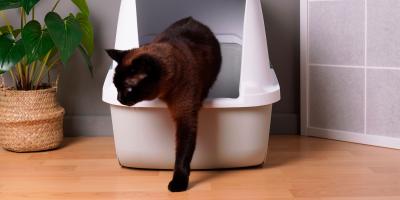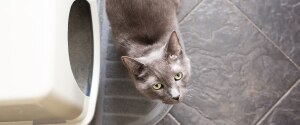
There are many potential causes for cat urine crystals to occur in your feline friend. Sometimes the crystals are triggered by dehydration and can be remedied by simply increasing her daily water intake. However, urinary crystals can also be a sign of more serious issues, such as a bladder infection. Just like in their human companions, cats often endure a great deal of discomfort when experiencing a bladder infection and may need antibiotics to recover from the illness.
If you've noticed urinary crystals in your cat's litter box or seen her struggling with constipation, it's time to contact the vet and make certain that your cat is carefully examined. By receiving a proper diagnosis, you can work alongside your veterinarian to get your furry companion on the road to recovery and help prevent the issue from recurring again in the future.
Signs Your Cat Has Urinary Crystals
Besides visually confirming crystals in your cat's urine after they've used the litter box, there are other symptoms that you can watch out for if you suspect something is wrong with her urinary tract health.
Strong Smelling Urine
Unusually potent or ammonia-like odours when your cat urinates can be a clue that can help your veterinarian in their analysis. This can be triggered by a buildup of bacteria in her bladder, or it can mean her urine is too concentrated, which has been known to lead to crystal formation.
Red Tinges in Urine
Spots of blood or a reddish discoloration in your kitty's urine is another indication of troubles in her urinary tract.
Physical Distress
Crystals can cause your four-legged companion to cry in pain during urination or frequently lick their genital areas. If the crystals become large enough, they can partially or completely block her ability to urinate. If you witness your cat straining and failing to urinate, contact your vet immediately as this condition can lead to potentially dangerous and, sometimes, fatal side effects.
Treatment Options for Cat Urine Crystals
Your veterinarian may want to run tests to determine the pH level of your cat's urine, as slightly acidic urine levels can help reduce urine crystals in cats. A dietary change may be recommended to adjust your kitty's pH balance to dissolve the problem naturally.
If the vet suspects the crystals have grown into bladder stones in your cat, they may order X-rays or set up a procedure to remove the obstructions.
Simple Steps to Prevent Urinary Crystals in Cats
Urinary tract diseases are among the most common ailments your feline companion will deal with throughout her life. While it's normal to experience some issues, there are measures you can take to help keep her healthy and problem-free.
Increase Water Intake
Hydration is one of the most effective methods in dealing with cat bladder infections and urinary crystals. Though felines can be particular in their drinking habits, there are ways that you can encourage healthy behaviours in your cat's normal routine by making it easier for her to stay hydrated.
- Change water bowls daily to prevent bacteria and pollutant buildup.
- Choose containers that are shallow and ensure the water is easy to access.
- Set up several water dishes throughout your home to promote regular drinking.
- Ensure drinking stations feel safe and comfortable to reduce anxiety.
- Make it more fun and engaging for your kitty with a drinking fountain or dripping faucet.
- Try including wet food in her diet to augment water intake.
Nutritional Diet
Maintaining a healthy diet is a key component to preventing problems in your kitty's bowels and bladder. Consult your vet about designing a diet that best suits your cat's individual nutrition needs. If you like to treat your furry friend to snacks in addition to their meals, be sure to ask for guidance on topics such as how often is okay and what types of treats are ideal. Since nutrition requirements change for felines according to their age and other factors, be sure to update the plan as needed.
Reduce Stress
Stress can increase your cat's chance of falling ill. While it's hard to understand cat behaviour at times, no one knows your kitty as well as you do. If you notice changes in her attitude and actions, spend some time observing her to determine the cause and help her out with a solution such as muting a particularly loud appliance or maintaining a comfortable temperature in the house while you are at work.
Increase Exercise
Obesity and lack of physical activity are additional factors that contribute to bladder stones in cats. Supporting her playtime, however, is an easy way to ensure your kitty maintains a healthy weight. On top of this, the boost in activity can promote more frequent urination and help stop crystals from forming in the first place.
Consider giving her a new toy if she seems listless or disinterested with her old playthings. Cats often require new stimulants to keep them engaged. Cat ledges are another good way to foster exercise because cats naturally enjoy jumping and climbing to high locations. By giving her a safe environment to climb, you can help protect her from injuries caused by falling objects and use her normal instincts to fuel her activity.
Though there are contributing factors for cat urinary crystals such as breed, gender and age that you can't change, there are several actions you can take to improve your cat's health and lower her risk of complications. Explore our past articles to learn effective methods and resources to enrich both your lives.
Related articles



